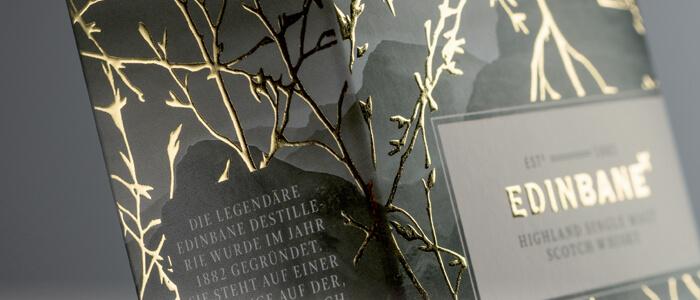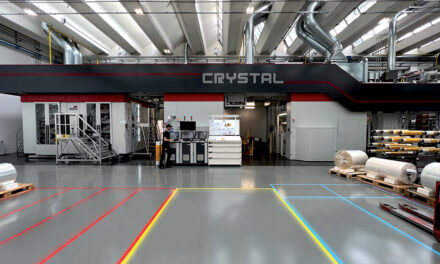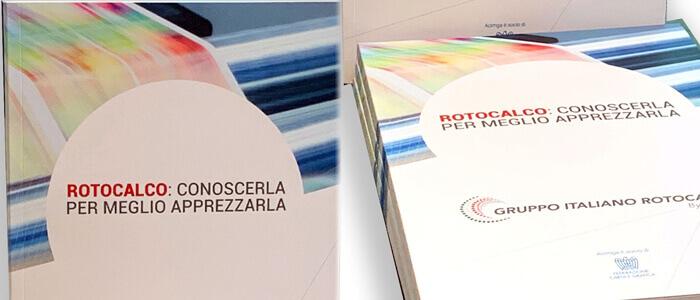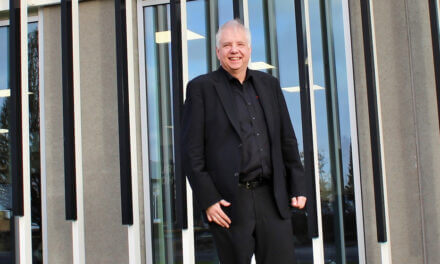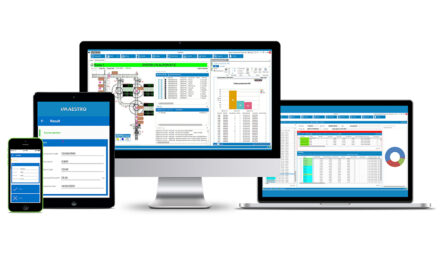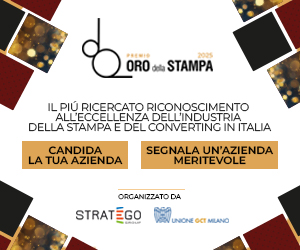The InfoTrends data and the reflections of Bobst, Esko, Luxoro-Kurz, Kodak, Koenig & Bauer Flexotecnica, Omet, Uteco on a construction philosophy that wins through in labeling and now, with more doubts than certainties, faces onto other applicative horizons.
In this Converting Special we deal with hybrid printing: a phenomenon that is talked about a lot (last Labelexpo Europe was the confirmation) and which sees practically all the great players of flexo and digital committed, with a growing swell in finishing. However, given the quantity and variety of proposals in the field, it is not easy to understand what it is about and above all to evaluate when and why to invest in this type of technology. Therefore we asked a group of companies active in Italy, which provide state-of-the-art technologies for prepress, printing and finishing-ennobling, to help us define the phenomenon by identifying salient characteristics, strengths and limitations, as well as market prospects. And an authoritative market research firm to delimit and quantify the same.
Who prints hybrid (and what type)
In 2019, hybrid machines for label printing in the EMEA area represented 8% of the installed fleet of 1280 printers, compared to 92% of “standalone” machines. This is the data provided by Bob Leahey (Director Color Digital Label and Packaging at Keypoint Intelligence, InfoTrends Divison), extrapolated from the InfoTrends “Color Digital Label Printer Forecast 2018-2023” study, and it says many things. As Bob Leahey – speaking of hybrid label printing – explains, « the EMEA area is currently 85-90% western Europe. To avoid misleading approximations, we have only considered machines that combine flexo stations with color inkjet as hybrid. We have not included other configurations on the market, such as digital printers that integrate lamination and die cutting, due to the lack of sufficient and sufficiently clear data ». The choice to focus the study on the label makers, however, was practically obligatory: hybrid printing machines are practically only found here. «In packaging, for example – Leahey considers – a great variety of substrates with peculiar difficulties (flexible films, for example) come into play; moreover, the finishing of 3-dimensional packaging (cartons etc.) is slower than printing, at least for now, effectively limiting hybridization.
Hybrid or hybridized?
Hybrid machines offer specific advantages but also, of course, specific limits, including their considerable cost. So all today’s OEMs have hybrid machines in their catalogue (as well as already installed) and, alongside the names mentioned in the following pages, one need mention actors such as Gallus, Mark Andy, MPS, Nilpeter – but also FFEI (UK) or Canon, Leahey suggests. «The same companies – emphasizes the expert – are often also large suppliers of flexo machines, with hundreds of customers working in analogue and that therefore represent a significant potential outlet for the hybrid. At the same time, another – so to speak – “parallel” and certainly important phenomenon should be mentioned: the “hybridization” of existing lines by retrofitting CMYK inkjet modules (and not only those, Ed.)». But that’s another story.
“Hybrid printing”: everyone talks about it, but what is it?
If we want to talk about hybrid printing by sticking to objective data, typically that relating to installed machinery (as Infotrends suggests in the introduction), we must only consider machines that combine flexo and digital printing technologies in-line. since – as Bob Leahey considers – we don’t have enough information and figures for the others types of hybridization. However, gathering analyses and testimonies of the machines, equipment, consumables and software manufacturers that contribute to forming multiprocess digitalized platforms – as experts believe it is more correct to call the phenomenon – a more complex picture takes shape. Which sees all the other printing technologies (screen printing, gravure and even offset printing) and various other complementary processes with all the pros and cons, added together alongside the classic flexo-digital combination.

A label phenomenon
Hybrid printing, given by all in progressive development, is therefore redefined by our experts as «multiprocess printing on machines of various types (platforms, fixed and mobile units, etc.), to which is added the digital printing unit for the reproduction of variable data» (d’Annunzio). «Today we talk about hybrid as a new phenomenon – adds the manager and “inventor”(Senior Innovation Advisor and Hybrid Program Manager is one of his qualifications in Bobst) – but in reality it has always been done on labels. Gallus, for example, in 1980 presented a machine equipped with silkscreen printing and hot foil gold stamping». Kodak agrees and specifies: today hybrid printing means a process that not only integrates a digital solution inline that can add quality and speed to conventional equipment, but constitutes a 100% customized system, capable of generating new value to an existing machine yard without major financial investments. With this in mind, the harmonization of analogue and digital technologies does not only concern printing but also finishing. We do not know if OEMs would literally subscribe to this claim, since in the catalogue of all manufacturers contains at least one brand new “hybrid machine” (which requires an ad hoc investment). However, all of them also include complementary and post-printing processes in the idea of hybridization. In Bobst, Matteo Cardinotti (Head of narrow & midweb as well as multi-process & converting Product Line and Managing Director of Bobst Firenze) testifies, one speaks of a hybrid machine when the digital is accompanied by a part of printing/converting that is not limited to the mere die or flexo varnishing unit and can also include finishing functions. Enrico Rimini, Chief of Uteco‘s Digital Printing Business Unit, states that «the hybrid machine integrates different technologies to exploit the strengths of one of them and, through the others, to add value or complement weak points» and he details: digital, flexography, rotogravure, offset, but also finishing, converting, lamination, cutting… Marco Panzeri, Omet Product Manager, adds a precious practical notation: the type and quantity of technologies integrated in the hybrid machine is a function of the final result to be obtained. But even if we wanted to limit ourselves to the classic flexo + digital combination – the manager recalls – flexographic units can also be used for finishing and varnishing applications and therefore their presence is enough to extend the range of a hybrid machine to post printing. Maria Costantino, Sales & Marketing Manager at Koenig & Bauer Flexotecnica, in turn offers an original starting point, proposing to also classify machines capable of processing both solvent and water-based inks as “hybrids”, with all that this entails in terms of ad hoc inking and drying. The demands for sustainability expressed by the market are so significant as to justify the development of “amphibious” systems, capable of printing with both technologies, stresses the manager.
[su_box title=”But you have to start from the prepress” style=”glass” box_color=”#e6000a” radius=”5″]
Giovanni Vigone, Sales Manager Italy & Spain Esko
Hybrid printing is being talked about more and more: why? Because the market requires it and the reasons are known: in labeling in particular, especially in small batches, being able to carry out all types of processing with a single machine can be, in principle, more effective and advantageous. Although, of course, it is necessary to carefully evaluate its performance – it is not said that doing everything also means doing it well – and above all you have to consider the inevitable greater complexity of the process and, consequently, of the management of the same.
What are the main problems?
From our point of view, as a prepress software vendor, hybrids are driving traditional technologies towards digitization, which is good. At the same time, however, they are short run machines, and to justify the investment they have to “run” a large number of jobs, which must then be managed. The critical issues, therefore, do not arise from the machine but in the prepress phase which, if inadequate, becomes the bottleneck. As complexity increases, there are only two ways ahead – increase the number of employees or automate processes – and, although theoretically it is clear that the latter is the most reasonable, many label makers are still not able to make this step.
So what advice would you give to a user oriented towards hybrid printing?
Not to start from the machine but from the optimization of the prepress flow. Without going into technicalities, just consider that to create an 8-color label, perhaps with special processes, it is necessary to define all the parameters of each step (of the four-color process that will be digitally printed, of the gold that will be silkscreened, of the white spread in flexo and so on), with the respective curves, shades, rulings, etc., and then send them to the right unit. With in the middle the realization of the print forms and many other steps. It is very complex and 50% of labelmakers still carry out all these operations with traditional methods with a high level of manual skill involved. In short, the difference is made by the digitalization of the prepress, to ensure that the operator only retains the functions that pertain to him, and that the rest travels automatically.
The Esko prepress ecosystem includes the Artpro plus automated editing module, the Automation Engine for the workflow automation, and the WebCenter module for the approval cycle management.
[/su_box]
Why it came into being (in response to what needs and application sectors), when and by whose work? Who are the main industrial players today? How has the demand evolved? And the technology?
Bobst: The need to use hybrid machines came into being to optimize costs according to the length of the print runs. Thinking about the synthesis of conventional and digital, Domino stands out as a forerunner; Gallus, Mark Andy and Bobst subsequently developed proprietary digital technology while other manufacturers continued to offer products made in partnership with digital companies (Mps with Domino, Omet with Durst, NilPeter with Screen …). The technology is always inkjet Drop on Demand but the type of head changes, with the Fuji Samba used by Bobst, Gallus and Durst which today represents the state of the art in terms of speed and resolution.
Kodak: Hybrid printing was created to respond to needs expressed in all areas of printing (commercial, editorial, packaging, labels …), namely speed, customization, job complexity, reduction of print runs and increase of small orders, not to mention quality. With this approach, printers can make flexibility a strength and a distinguishing feature, also knowing that they can count on an extraordinary advancement in technology.
Koenig & Bauer Flexotecnica: The radically modular design of the new generation, fully automatic, flexo Cl allows the combination in line of different product printing and finishing as well as converting modules – incorporating special applications and complementary printing techniques such as rotogravure, offset or digital. Modern flexographic machines allow coatings to be carried out, in a single pass, before printing (primer), either continuously or registered, as well as gloss and protective lacquering, on the front or back of the substrate, after printing, as required by the complex graphic structure of some packaging. This is the horizon towards which the supply chain R&D is working.
Omet: Each technology has its own specific advantages and limitations and hybrid printing aims to combine the benefits or compensate for the limits of the techniques involved, to broaden the possibilities of the printers. Omet was one of the first companies to believe in hybrid and tailor-made configurations. The first digital + flexo projects date back to more than 10 years ago and even before that we started working on “home-made” offset and web units to be integrated in to flexographic platforms that today are the flagship of the Omet range, especially in the medium range. With striking cases such as the Varyflex for Lottery scratch cards produced in 2010 specifically for the Chinese market, with flexo, offset and digital units in hybrid configuration for a length of 54 m.
Uteco: Customers have been asking for customization of the printing line for many years to increase its effectiveness, efficiency and added value according to its internal flow and, if a date of creation or a first author cannot be pinpointed, it is nevertheless a growing trend. The main industrial players are those who historically have know-how in multiple technologies, or who collaborate with other synergistic companies – as we in Uteco did. Our percentage of hybrid machines made on demand is growing but we also have hybrid-born lines in our catalogue. The digital machines (such as our Sapphire EVO) and the flexographic ones (typically CI flexo with gravure downstream) are the most suitable for a hybridization process, but hybrid offsets already exist and in Uteco we have also created hybrid gravure machines, for example for security applications.
[su_box title=”Finishing? Fine and useful” style=”glass” box_color=”#e6000a” radius=”5″]
«Hybrid printing carries out all the steps of a job in a single process, without having to transfer the support and, with the same objectives of effectiveness and efficiency, can involve printing alone, finishing alone (with multiple technologies and methods) or print combined with finishing. Created to integrate variable data and customizations, today it is mainly adopted in web/rotary labeling and packaging – areas in which, not surprisingly, finishing is also growing. It is therefore in labeling – where it is easier to experiment and combine conventional and digital technologies – that hybridization has generated the most interesting innovations». Luxoro-Leonhard Kurz Business Manager Marco Gaviglio thus sketches out the topic, and then goes into the merits of the proposals for online embellishment of the German brand, represented in Italy by the Parona (PV) based company.
Special effects for decoration and more
Kurz fields two types of solutions perfectly integratable on a hybrid line. The first is the DM-Jetliner ® for self-adhesive labels in plastic and coated papers, which carries out multicolour overprinting by metallization, with reels between 150 and 350 mm. The minimum thickness of the coating also makes it suitable for reel printing, both for short runs and customization and for unique projects. DM-Jetliner® also reproduces diffractive designs and continuous holograms that also play an important anti-counterfeiting role.
Synchronous holograms
Kurz’s second proposal for embellishment on a hybrid platform is called Distorun. It prints single image holograms with a maximum precision and original technology register system, which enables synchronous working with the printing machine, opening up new opportunities in labeling and, more generally, in cold rotary printing. Distorun can use up to three coils in parallel, optimizing the use of the foil to reduce waste and increase plant productivity. The management software enables the reinsertion of the partially used reel in one or more new work cycles.
The new frontiers? Cardboard
Paper converting, on the other hand – says Gaviglio thinking of the classic application of Kurz technologies – for the moment does not field in-line digital finishing methods: Finishing techniques are widely used, and also to obtain more attractive customisations with variable data, but still with a double passage and leading to offline stains. In this sector, therefore, there is ample space for development and ample margins for innovation and Kurz has just presented its ad hoc proposal. These are the Steinemann machines, synonymous with hi-level digital finishing, offered in two models: Colibrì, with coating roller for full surface UV varnishing, and dmax, a digital inkjet unit for spot and relief varnishing, with a Dfoil module for digital metallization if requested.
[/su_box]
How do you see the future of hybridization of technologies in the printing and converting of flexible packaging, paper&board products and labels?
Bobst: If we take the label and consider the cost, it is more convenient to print in pure digital and carry out the conversion operations offline in the case of “ultra-micro” runs; in turn print the “micro short” runs with the hybrid machine, also according to the required finishing; use conventional printing for short (also here depending on the finishing), medium and long runs. This is why I believe that hybrid printing will take away a slice of the market from both pure digital and flexo – while it is too early to say to what extent this will happen.
Koenig & Bauer Flexotecnica: To improve the functionality and performance of their own systems, printers – not only of labels, but also of flexible packaging and much more (electronic boards, biomedical, textiles …) – are looking for increasingly versatile processes capable of converting the most diverse substrates and consumables, even new and difficult ones such as eco-compatible plastics. It is an objective that requires the commitment and collaboration of the entire supply chain, with which we create a system by working both on individual units and on optimizing the process.
Kodak: With hybrid systems, packaging and label manufacturers can increase their production flexibility by optimizing the advantages of both traditional and digital technologies. Thanks to automation, the two integrated techniques reduce costs and improve productivity; they also increase the efficiency in prepress and optimize the capacity of the line as a whole allowing you to do more in less time and with fewer errors, reducing start-up times, execution times and, yet again, the related costs.
Omet: There are those who appreciate and focus a lot on the all-in-one concept – that is, a machine that integrates different technologies to create a final product in one run – and those who are not yet convinced. Probably in the field of labels the first path will be the one to follow, while in flexible packaging and paper converting, other factors guide technological development, to the point that digital technology has not yet established itself here.
Uteco agrees but with different accents. In flexible packaging – Enrico Rimini assesses – the trend towards hybridization will continue, albeit without reaching exaggerated peaks due to the delicate balance of advantages and disadvantages in managing integrated or separate lines. Uteco has in fact always invested in multiple technologies in the awareness that there is no single answer to all needs but that one must be able to offer each user the most suitable machine as the case has it.
The offer fielded (state of the art and construction philosophies)
Bobst: The Master DM5 was presented at Labelexpo Europe 2019 as the most automated machine on the market, with the highest productivity and print quality. It combines the exclusive Bobst automation solutions in the flexo sector (automatic change of cylinders and die plate) with MouventTM Ink-Jet digital technology ensuring optimal flexibility for the production of labels with high added value, with extremely fast setups and a quick return on investment.
Koenig & Bauer Flexotecnica: has long been manufacturing 8 or 10 color central drum flexo machines, with in-line coating or roto varnishing elements, for cold seal, PVC coating, tactile varnishes or full-bottom internal printing. The recipients are the printers of flexible packaging, beverage bags, stick packs, or labels, for which they create added value in terms of print quality, reduction of waste and ink consumption. The philosophy is to identify the “right” configurations for each application, with the automatisms that minimize process times and waste and maximize the profitability of the system, this for the large user as for the SME looking for competitive advantages.
Kodak: There are over 1,500 Kodak Prosper S series printing solutions (with Kodak Stream Continuous Inkjet-CIJ technology) installed in all fields all over the world. Kodak also recently announced the introduction of Kodak Prosper Plus Imprinting for the packaging sector. They include four new printing components (for narrow and large formats) with speeds up to 260 and 600 mpm), inks and pre-coatings. A successful example in folding cases? That of Zumbiel Digital, converter of cardboard packaging, which has focused on customization on an industrial scale.
Omet: The custom orientation explains the frequent integration of different printing technologies on the same machine, such as the X6, typically for labeling, capable of integrating flexo-, finishing and converting with offset, digital up to 8 colors and rotogravure units, while in packaging Varyflex offers the most versatile platform. Omet has sold more than 100 lines with a confidentiality agreement and presented two new developments at Labelexpo: The flexo-digital hybrid XJET in collaboration with Durst and the new X7 in the 670 range with newly designed high performance flexo and roto units.
Uteco estimates that 25-30% of their approximately 3,500 current installations are classifiable as hybrids. The fields of application? All of them: flexible and rigid packaging; industrial bags, pouches, sacks; shrink wrap, labels; special security applications and more. Many the interesting ranges starting with the Sapphire EVO digital. In the flexo sector Onyx, Crystal, Diamond and the other Uteco lines can be integrated with gravure, digital, laminating, cutting and embossing units; and with the due changes, the same goes for the rotogravure printing presses such as Next and NXS.
[su_box title=”Multiprocess challenges: analyses and solutions” style=”glass” box_color=”#e6000a” radius=”5″]
Federico d’Annunzio is one of the leading experts in flexo and digital printing technologies. We benefited from this in this interview, where he reviews some sensitive aspects of multiprocess platforms (he can’t take the term “hybrid”) and the type of approach chosen in Bobst to deal with related problems. Here is a free summary by topics.
The main difficulty encountered in designing this type of machine – says Federico d’Annunzio – is the classic bottleneck of any solution that encompasses many processes, where the slower one slows down all the test. In printing 100 m/min (+/- depending on the substrate) already represents an excellent result. However, it must be added that in recent years the speed has improved significantly, as has the quality of the printout and the cost, especially running costs (inks, maintenance of the heads, etc.) so much so that today a multiprocess machine can compete, or at least be compared with analogue machines. The main challenge, therefore, is to be able to perfect the weakest element of the process. What we did in Bobst – explains the expert – was to push digitization beyond the limit posed in all analogue processes (for example the start-up times of the printheads), obviously being aware of one insurmountable limit: that analogue can never reproduce variable data.
Machine and labor costs
Another aspect to consider is the operational cost effectiveness of a solution. Having to invest in digital printing, one thinks of the cost of the machine but not of the labor required alongside. Indeed the first characteristic of digital is that it does not require the print forms and all the operations necessary to set up and move units, clichés and anything else that makes the infrastructure of an analogue machine so complex. And the label maker has also had to learn how to do his sums: to carry out complex jobs such as in labeling, where for each job a quantity of sleeves, clichés, blades and dies need to be changed, along with an infinite number of physical processes, where the operator’s commitment must be carefully evaluated.
“It will be amazingly difficult!” But that was not the case
«When I was appointed head of the Bobst hybrid machines project, everyone said “it will be very difficult”, fearing problems with register, tension and a lot of other” physical” things. But it was not so because if you do things well, they work – and the fact that, unlike other digital machines on the market, our machines do not touch the coil in fact helps». The importance of software also cannot be overstated: integrating the various programs is difficult but it is only a somewhat higher level of complexity than normal, especially given that the automation of functions and processes is now also advanced in flexo and other technologies, which now speak a common language.
From labeling to the rest of packaging
“Hybrid” machines are being adopted in labeling but less in flexible packaging because this area is only now beginning to experience the needs satisfied multiprocess machines. Until recently packaging was either printed in roto or flexo: something incompatible with narrow web, which requires the management of a great variety of functions, and not only in printing but also in finishing. Digitization is however at any rate an evident and unstoppable trend in all areas, where the need for customised printing and to quickly change graphics and messages defines the new frontiers for technology suppliers.
Philosophy and people
Bobst got to this market late, and this put it at a disadvantage, «but we have a great strength that comes from a series of different choices, starting with the construction of our inkjet heads inhouse, as well as our drive to work systematically to overcome all machine “bottlenecks”, in a process of continuous improvement (which also involves our own solutions). Some examples? In flexography, scrap management is manual and requires several minutes of machine downtime at every job change. Fine: we have fully automated it. We did the same for ink on-demand (we have totally reconceived the printing unit) the cylinder change, the washing or, in converting, the change of the sheet as well as scrap collection». The secret of so much fertility? «Beyond the logical path that is taken in reconsidering a project, it is the capacity for invention that really brings results And this depends solely on the people who work in a company».
[/su_box]

